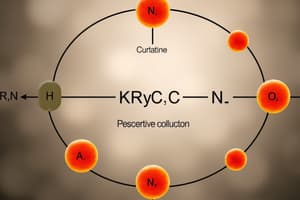Podcast
Questions and Answers
What is the site of oxidative decarboxylation of pyruvic acid?
What is the site of oxidative decarboxylation of pyruvic acid?
- Mitochondria (correct)
- Nucleus
- Cytosol
- Endoplasmic reticulum
Which of the following coenzymes is NOT required for the oxidative decarboxylation of pyruvic acid?
Which of the following coenzymes is NOT required for the oxidative decarboxylation of pyruvic acid?
- Lipoic acid
- FADH (correct)
- TPP
- NAD+
How many ATPs are produced from the complete oxidation of one mole of glucose?
How many ATPs are produced from the complete oxidation of one mole of glucose?
- 36 ATP
- 38 ATP (correct)
- 26 ATP
- 30 ATP
What condition stimulates the Krebs cycle?
What condition stimulates the Krebs cycle?
Which of the following is a function of the hexose monophosphate shunt?
Which of the following is a function of the hexose monophosphate shunt?
What is the primary role of succinyl-CoA produced in the Krebs cycle?
What is the primary role of succinyl-CoA produced in the Krebs cycle?
Which of the following tissues primarily utilizes the HMP shunt?
Which of the following tissues primarily utilizes the HMP shunt?
In the absence of oxygen, how many ATP are generated by glycolysis?
In the absence of oxygen, how many ATP are generated by glycolysis?
Which energy molecule is produced from 2 Pyruvate during aerobic respiration?
Which energy molecule is produced from 2 Pyruvate during aerobic respiration?
Which of the following substances is NOT produced by the pentose phosphate pathway?
Which of the following substances is NOT produced by the pentose phosphate pathway?
Flashcards are hidden until you start studying
Study Notes
Oxidative Decarboxylation of Pyruvic Acid
- Occurs in the mitochondria and is irreversible.
- Catalyzed by a complex of 3 enzymes and requires 5 coenzymes: TPP, lipoic acid, COASH, FAD, and NAD+.
Krebs Cycle
- Final common pathway for the complete oxidation of acetyl-CoA.
- Acetyl-CoA can be produced from the partial oxidation of carbohydrates, lipids, and protein.
- Located in the mitochondria of every cell.
Regulation of Krebs Cycle
- Rate is determined by cellular ATP demand.
- Low ATP and high ADP/AMP and NAD+ signal increased Krebs cycle activity leading to higher ATP production.
- High ATP and NADH signal inhibition of the Krebs cycle reducing ATP production.
Importance of Krebs Cycle
- Major source of energy, oxidizing acetyl-CoA produces 12 ATP.
- Provides succinyl-CoA (active succinate) for:
- Hemoglobin synthesis
- Ketolysis
- Detoxification
- Supplies the body with precursors to amino acids:
- Alanine from pyruvic acid.
- Glutamic acid from α-ketoglutaric acid.
- Aspartic acid from oxaloacetic acid.
Energy from Glucose Oxidation
- In the absence of oxygen, only anaerobic glycolysis occurs, generating 2 ATP.
- When oxygen is present, a complete oxidation of glucose generates 38 ATP:
- Glycolysis: 2 ATP + 2 NADH + 2 Pyruvate = 8 ATP
- 2 Pyruvate → 2 Acetyl-CoA + 2 NADH = 6 ATP
- 2 Acetyl-CoA: 6 NADH + 2 FADH + 2 ATP = 24 ATP
Hexose Monophosphate Shunt (HMP Shunt)
- Alternative pathway for glucose oxidation that generates pentoses as intermediates.
- Occurs in the cytosol of cells requiring NADPH:
- Liver, adipose tissue, lactating mammary gland (fatty acid synthesis).
- Adrenal cortex, gonads, placenta (steroid synthesis).
- Red blood cells (maintains ferrous iron in hemoglobin and membrane resistance to hemolysis).
- Retina, cornea, lens (reduction of retinal to retinol).
Functions of HMP Shunt
- Produces NADPH + H+ (reduced coenzyme II) used for:
- Synthesis of fatty acids.
- Synthesis of cholesterol.
- Synthesis of certain steroid hormones.
- Produces pentoses-5-phosphate (ribulose, xylulose, and ribose 5-P) necessary for:
- Formation of nucleosides (base-pentose).
- Formation of nucleotides (base-pentose-phosphate).
- Formation of nucleic acids and nucleoproteins.
Uronic Acid Pathway
- Occurs in the cytosol.
Studying That Suits You
Use AI to generate personalized quizzes and flashcards to suit your learning preferences.




